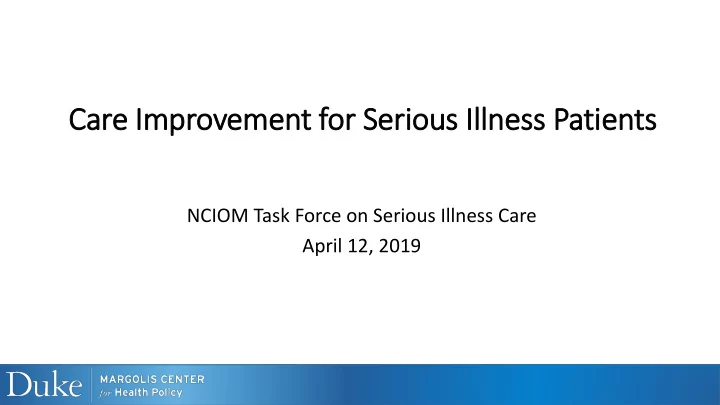

Ca Care e Improvem ement for or Ser Serious I Illnes ess Patien ents NCIOM Task Force on Serious Illness Care April 12, 2019
Who are the seriously ill? • They have: o Serious medical condition or many complex comorbidities o High utilization o Functional limitations o Caregiver stress/limitations • Related populations: high need/high cost, complex, end of life, high risk… o Points in this section relate to all of these groups.
Value-based care can address shortfalls in serious illness care • Fragmented care (e.g. disparities in quality, siloed delivery) • Fee-for-service infrastructure is a major driver of poor care coordination o Essential activities (e.g. social supports, home visits, patient education, SDM) often not reimbursed • Current models often fail to integrate patient/caregiver care preferences and thus may not accurately treat a patient’s pain and symptoms
Ways for serious illness care to fit into value based models • Integrate into existing models (e.g., ACOs) o Wide reaching models, no need to stand up o Require some modifications to model given unique population • Develop new payment models exclusively for seriously ill o Interest in CMMI and among MA plans o Can be difficult to identify this population exclusively • Regardless, health care organizations need help to improve care o Challenges making the business case, getting up-front capital o Challenges developing competencies to improve care for this population
Integrating into existing models: ACOs • ACOs are widespread ( >1000 nationally covering almost 33 million lives) • ACO incentives are aligned with goals of palliative care o Focus on care coordination o Financial flexibility through shared savings o High-cost, high-risk patients are a potential source of ROI • New final MSSP ACO rule expands tools for serious illness care (telehealth, etc.)
Integrating into existing models: ACOs interested, but early. • Overall: Interest in serious illness, but few widely implemented programs • Some hospital-led ACOs with IP palliative care services or teams; only a few ACOs implementing community-based palliative care • Many ACOs trying to identify high-risk/serious illness patients • Technical issues matter: attribution, risk adjustment, shared savings calculation, quality measures.
Developing new models for serious illness • CMMI expressed interest in new models o May build on previously developed models from C-TAC and AAHPM o Also models from MA serious illness programs • Challenges in developing new models o Seriously ill (and high risk, complex, high need) patients cycle—they are likely to not be high risk in the future o Hard to identify actionable populations with modifiable risk before they are high cost
Developing new models: Medicare Advantage • MA prime testing ground for serious illness payment reform o Highest adoption of APMs and advanced APMs o Can offer (or contract) care integration services to augment provider capabilities o Can invest in improving provider capabilities o Have flexibility to align benefit designs o Strong financial incentives (capitated adjusted by quality Star Ratings) • Many existing programs, largely through 3 rd parties (eg, Landmark, Turn-Key, Aspire) • Recent actions have increased flexibilities for MA plans (supplemental benefits, hospice carve-in through VBID pilot, telehealth)
Short-term opportunities to improve • Opportunities to improve existing models to better capture serious illness o Ex: Quality measures, attribution, benchmarking, risk adjustment • Identify MA serious illness innovations and share emerging lessons for greater implementation o This year’s bids expected to be first time for serious illness benefits; 2020 will be first supplemental benefits offered. o VBID hospice carve-in 2021. • Disseminate evidence on key organizational competencies for faster care reform o Ex: Population identification, business case for infrastructure capital, data systems and provider communications • Address social drivers for high need patients o Leverage community needs assessments/community benefits implementation plans to encourage focus on social factors affecting high need populations.
Recommend
More recommend